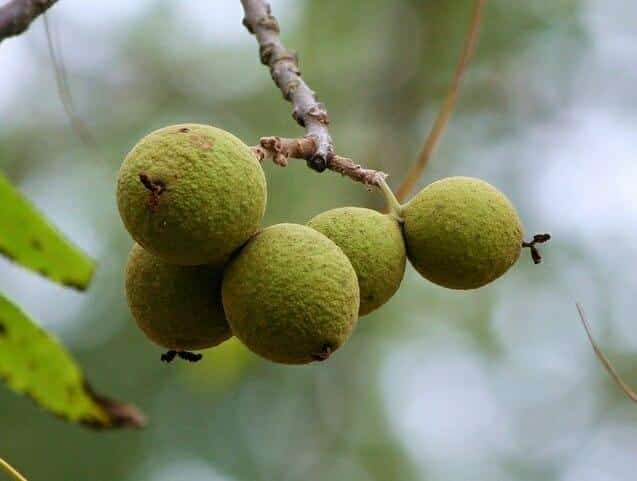When we think of foraging, we generally think of food. But once your belly is full, there’s a lot more to life than just eating. When you’re learning to forage, it’s important to keep in mind that clothing, tools and art are a vital part of the human experience.
Black walnuts are a great source of foraged food, containing healthy fats and high levels of protein. And the husks of black walnuts are useful in making dyes for clothing, leather, yarn, hair and naturally made ink for writing.
From a purely practical perspective, a dark-brown, earth-toned dye can be useful for creating camouflage clothing. Even light-colored hair against a dark-brown muted background can give away your position if you’re trying to hide. Using black walnut husks to dye both clothing and hair can help keep you concealed.
Let’s Get Started
To make dye from black walnut husks, start by collecting about a dozen black walnuts – that’s enough for a gallon of dye. Husk them immediately. The husks will begin to rot quickly, which makes them a lot less fun to work with.
Learn Unordinary Uses For Ordinary Stuff In “The Big Book Of Off The Grid Secrets”!
Husk the nuts by placing them on a rock or stump and whacking with a hammer or another stone. It can take quite an impact to get the fibrous husk off the nut. The outer husk (not the actual nut shell) is what you’ll be using to make the dye. Once you get the husk off, you still have whole walnuts in shells that can be dried and stored for later eating.
Keep in mind that the dye is very strong. If you’re working without gloves, your hands will be dyed brown/black and it may take weeks for them to get back to normal.
Crush the green hulls into small bits, about the size of a pea to maximize surface area. As you work, the hulls will quickly oxidize and turn to a dark brown color that will eventually be your dye color. Place the hulls from a dozen nuts into a large non-reactive enameled or stainless steel pot. Add 1 gallon of water and bring the mixture to a boil. Simmer for about an hour.
While your dye is cooking, you need to scour the material you plan to dye. This gets it really clean and removes any oils that will interfere with the dye process. Fill a pot with water and add in 1 tablespoon of washing soda and 1/2 teaspoon of household detergent. Place your cloth or natural fiber in the pot and simmer for an hour while your dye simmers in another pot.
Rinse your cloth to remove all the soap, and then place it in the pot with the black walnut hulls. Simmer with the walnut hulls, occasionally checking on the color. When your cloth is about a shade darker than your desired final color, take it out of the dye bath and rinse it until the water runs clear.
Allow the cloth to dry, and watch as the color changes slightly as the dye oxidizes further while the cloth dries. If it’s not dark enough once it’s dry, repeat the dye step of the process.
How to Avoid Stains
Be sure to wash clothing once or twice before wearing it or before washing it with other clothing to ensure that all the surplus dye is out; otherwise, it can stain skin or clothing.
To make ink, simmer the hulls for several hours before filtering through a muslin cloth or cheesecloth. For a darker color, concentrate the ink by simmering longer. Add a small amount of alcohol, like cheap vodka, to the final bottle to preserve your ink.
For hair dye, it’s a bit trickier. You’ll need to soak your hair in the dye for 10-15 minutes once the simmered dye has cooled. Apply a neutral oil around your neck and along your hairline, such as coconut oil. This will help prevent the dye from staining your skin (but it’s not foolproof…).
Place a bowl of the dye outdoors in a grassy area, and tilt your head back into the cooled dye. When you come out, be prepared to wrap your hair up in an old towel to keep it off your neck, and allow the dye to soak in for a while longer.
Rinse the dye thoroughly and allow to dry to check your color. If you want it a bit darker, repeat.
Have you ever used black walnuts for dye? What tips would you add? Share your advice in the section below:
 Off The Grid News Better Ideas For Off The Grid Living
Off The Grid News Better Ideas For Off The Grid Living




